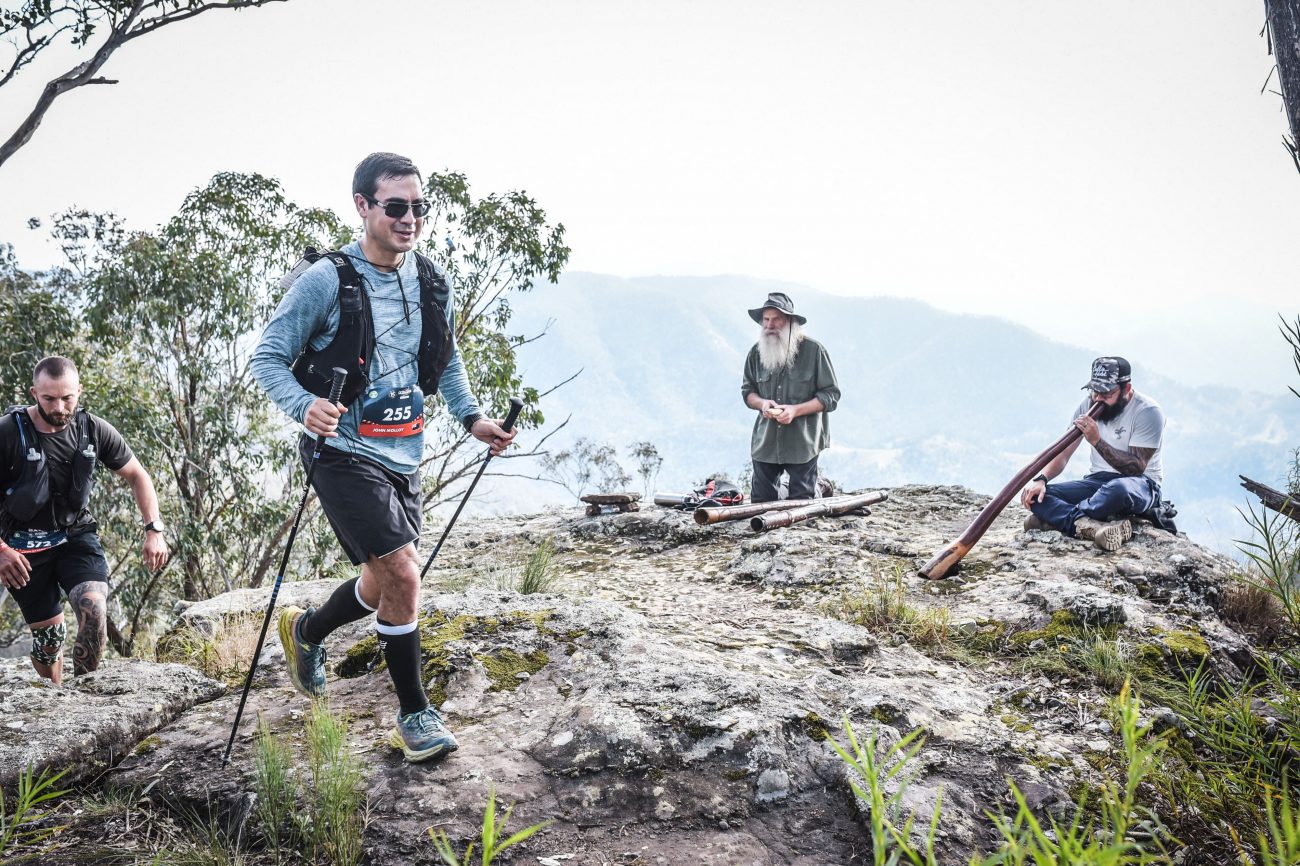
Ultra-Trail Australia 100:
100km # 8
Date:
May 13, 2023Fast forward another week and this time I’m at the Ultra Trail Australia (UTA) start line with Dr Andrew Stanley in Katoomba, the Blue Mountains, NSW. I’d originally entered the UTA in 2020 but covid intervened and flooding/landslides affected the rescheduled 2022 event so this start line was three years in the making. The first time I did the UTA was in 2015 (then called the North Face 100) and at the time it was one of the hardest events I’d ever done. I then returned in 2016 and 2017 but hadn’t done it since and hence my recollection of the course was slightly hazy. I remember the event being quite hard and the Furber steps (951 steps) at the 99km mark being particularly brutal. After a quick turnaround from the Rotorua Marathon last week, I wasn’t in racing mode for this one. As far as I was concerned, I was on holiday and my intention was to ‘enjoy’ this 100km. I was seeded in start group 2 with Dr Stanley which meant that I was expected to finish in the top 30% and before 15 hr and 25 mins. However, I thought that seemed unrealistic as my previous finishing times had been between 17 and 19 hours and I hadn’t particularly tapered for this event. As I lined up with Dr Stanley, he asked me what my tactics were. My reply was “I’m going to take it easy”. I was happy to start slow and lose my ego as quick as possible. One hundred kilometres is no joke and not a distance for show boating or chest puffing. The 100km distance is designed to slowly break you down and reduce you to nothingness. We both set off just before 6.30am and as of the trend of late, Dr Stanley raced ahead. Before long, I’m right at the back of my starting group and not long after that, the 50 km runners also race past me. By the time I had reached the Prince Henry Cliff walk, I was by myself and surrounded by lush rain forest. As I descended the Furber steps deep into the Blue Mountains National Park, I couldn’t help but feel intimidated. Going back up these will be an interesting prospect at 99km. The Furber steps was a memory that definitely hadn’t faded with time.
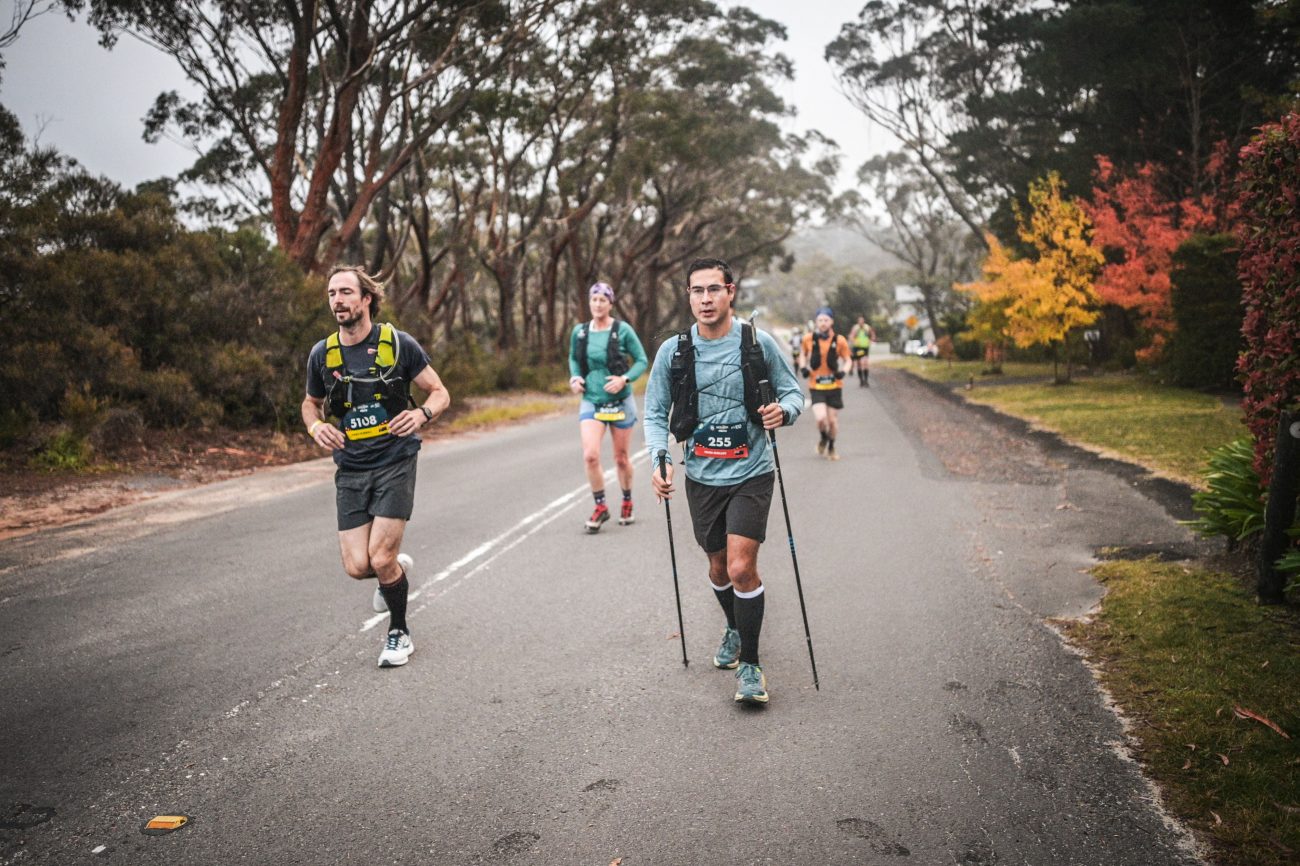
Feeling strong early on in the run
Having not run in Australia for such a long time, it was an amazing reawakening for my senses. The environment was so different compared to New Zealand! Initially it was green rain forest with moss covered vines and then it transitioned into increasingly common dry eucalyptus. The trail was firmer underfoot and the soil was generally drier so I could feel my shoe grip (and slide) differently. The rocky outcrops looked different (varying shades of grey and orange) and they also felt sharper to handle. As I negotiated past a rocky landslide, I eventually reached the Golden Stairs which was a sharp ascent through the trees and cliff faces. Parts of the path were treacherously narrow as I skirted along cliff faces. However, if you were brave enough to look, it offered spectacular views of the Jamison Valley and Mount Solitary. By the time I’d reached the 10km mark, I’d been going for one hour and 30 minutes and already I was feeling the strain. Despite trying to ‘take it easy’, that 10km section was probably one of the hardest 10km starts to any race I’ve done in a while. Though manoeuvring through the rocky landslide was quite technical, in retrospect, the difficulty arose from the terrain being so different to what I was accustomed to in NZ. It may’ve also been the slightly warmer Australian autumn. But the steps! So many steps! How I’d managed to forget about those initial steps I’m not too sure.

Heading up the Golden stairs
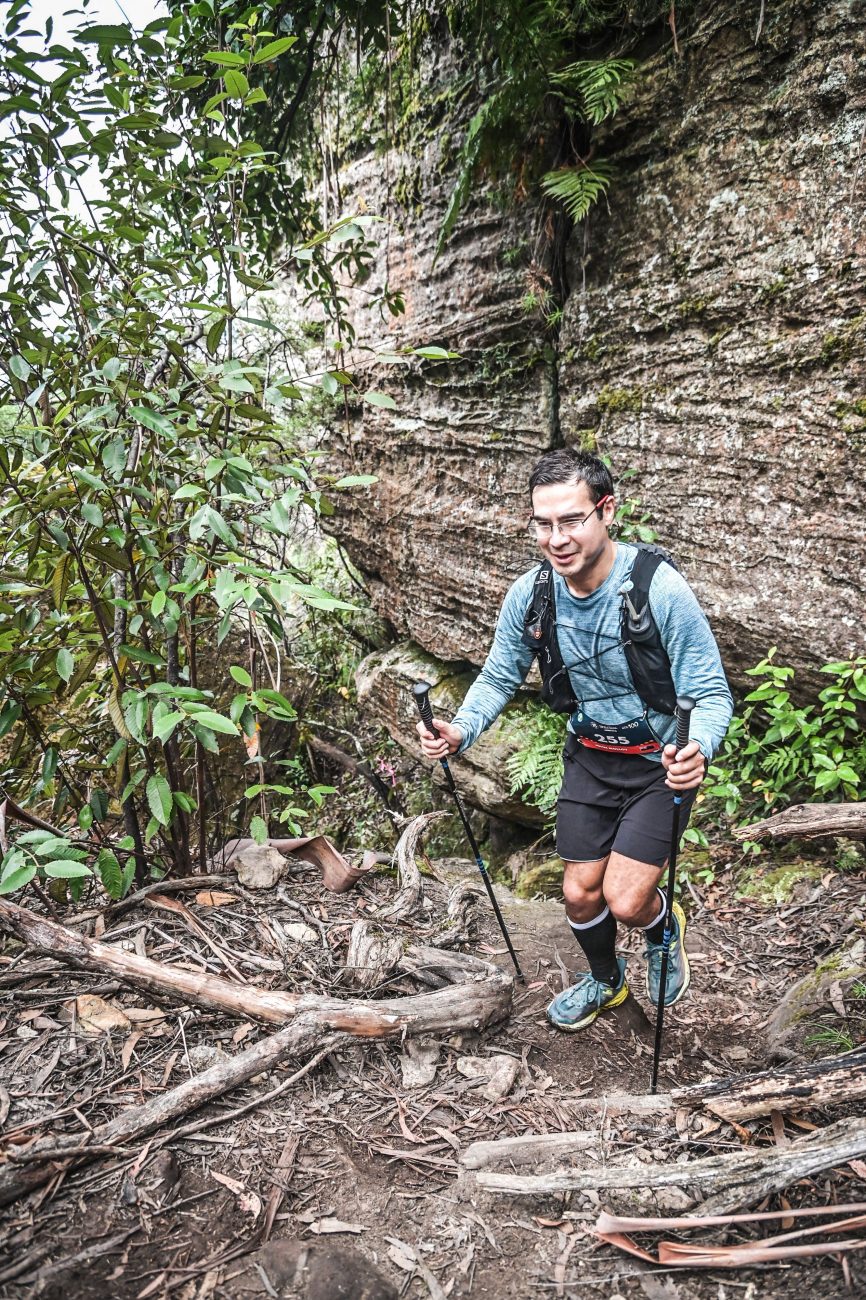
And along cliff faces
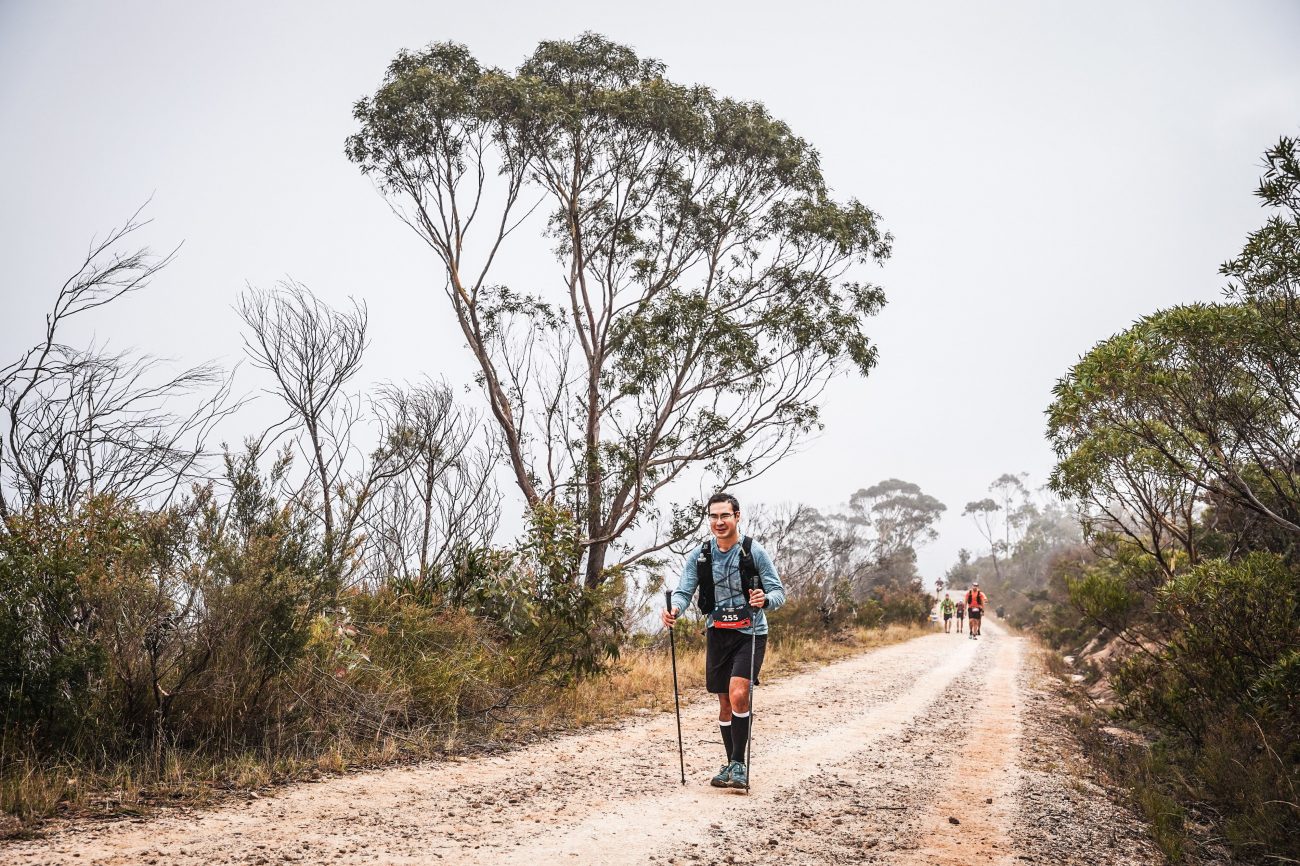
Along the Narrow Neck Trail surrounded by cloud
I didn’t spend too long at the first aid station after the Golden Stairs. It was still early days and it wasn’t too hot yet so I didn’t top up my water and only took a couple of waffles and chocolate bars for the trail. The next part of the course was along the Narrow Neck Trail which was well suited to those with a good road running background. The trail was on a dirt road with lots of straights and a few undulations so one could really put their foot on the accelerator if they wanted to. I knew we were high as we were surrounded by cloud cover (which at the time blocked the great wide open views of the Jamison and Megalong valleys either side of us). By this stage of the race, some of the runners who had started in the start group 30 minutes after me were beginning to overtake me. However, I restrained my ego and just let them be. Twenty kilometres into a 100km is way too early to start pushing it and I was happily still in holiday mode. Eventually we turned off the long dirt road and into some single trail and that’s when things started to get interesting again. Welcome the rope descents, chain guides, metal hand rails, and hand crafted wooden ladders designed to get us down off the ridge. A competitor next to me exclaimed “I didn’t think you needed to do a course in mountaineering to do this!” as I negotiated my way down. I then had flashbacks of the original Tarros ladder (used in earlier versions of the UTA/North Face 100) which was a far greater knee trembling experience and supposedly originally constructed “for the convenience of weaklings”. And so like the weak modern day man I was, I utilised all conveniences provided and carefully made my way down. How on earth did I forget about this section? After some pretty precarious single trail (where the cliffs appeared to fall away either side of you) I was back on dirt road again. The next section along Mitchells Creek Trail seemed to take forever and by the 25km mark, I’d inexplicably ran out of water. Of late for my longer runs, I’ve created my own aid station chart to keep track of distances and estimated times to aid stations. However, I didn’t even think of doing this for UTA as I assumed my previous experience would’ve been sufficient. Had I remembered that the distance to the next aid station was 20km and about 3.5 hours, then I probably would’ve left the Golden Stairs aid station with more than 750mL of fluid. As a result, I adjusted my pace to help stem any ensuing damage. When I do arrive at Foggy Knob aid station (32km in just under 5 hours total), I’m under minor-moderate damage control. The sun is out by now and it’s also getting hot. Holy shit! Despite trying to ‘take it easy’, I was only 30km into this race and I was close to shattered. It was time to give this race my full attention and respect. Holiday mode was over. I was transitioning into survival mode now.
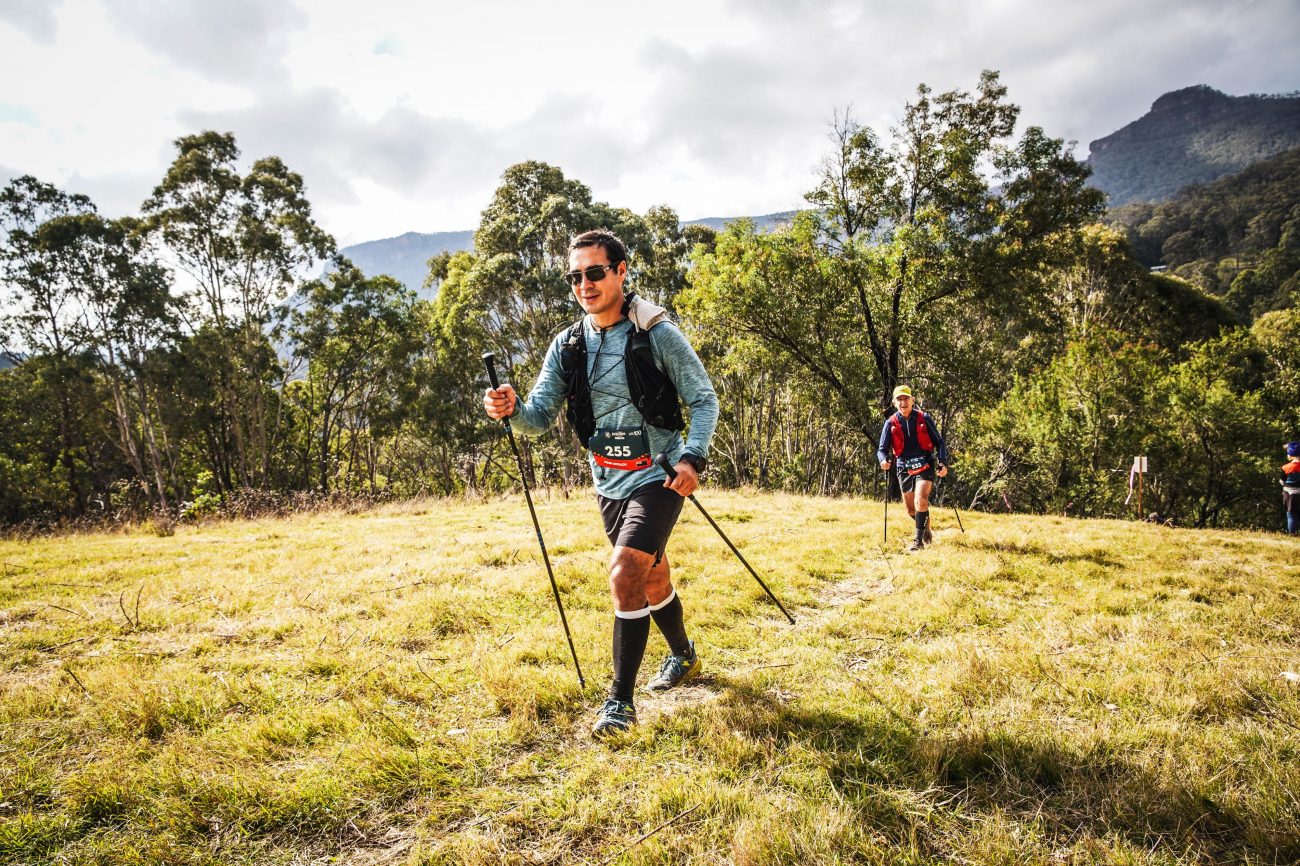
Coming into the Foggy Knob aid station
When I left Foggy Knob, I made sure that I left with 1.5L of fluid and also made a mental note that the next aid station was 14km away. I was now on typical Australian dry grass single trail as I negotiated my way up some pretty taxing hills. As I headed out towards the turnaround point at Ironpot Ridge, the gravity of what lay ahead really started to sink in. 70km to go. I clambered up and down some gnarly rocks near the turnaround whilst a couple of locals played their didgeridoo. This was fitting as I was also entering my own primitive world of survival. Any sight-seeing was now peripheral and no longer important. What mattered most was movement and where my feet were landing. The descent down the ridge was dry, dusty, and slippery but it eventually brought us into Eucalyptus shade which was a welcome reprieve. I stopped at the river crossing and wet my hat to keep cool before the long climb up and down (aptly named) Megalong Road. I eventually arrived at the Six Foot Track aid station (46km) and my cumulative race time was around 7 hours. I took my full complement of food and water and tried to move through this aid station quickly. I wasn’t even half way yet but already I was feeling reduced. I was in no man’s land. Neither here nor there. I knew I just had to keep moving. I remember seeing the 50km marker going up a slow incline along the Six Foot Track. I acknowledged it but almost immediately it became a distant memory as I fell deeper into a trance like state. This was the race of survival now.
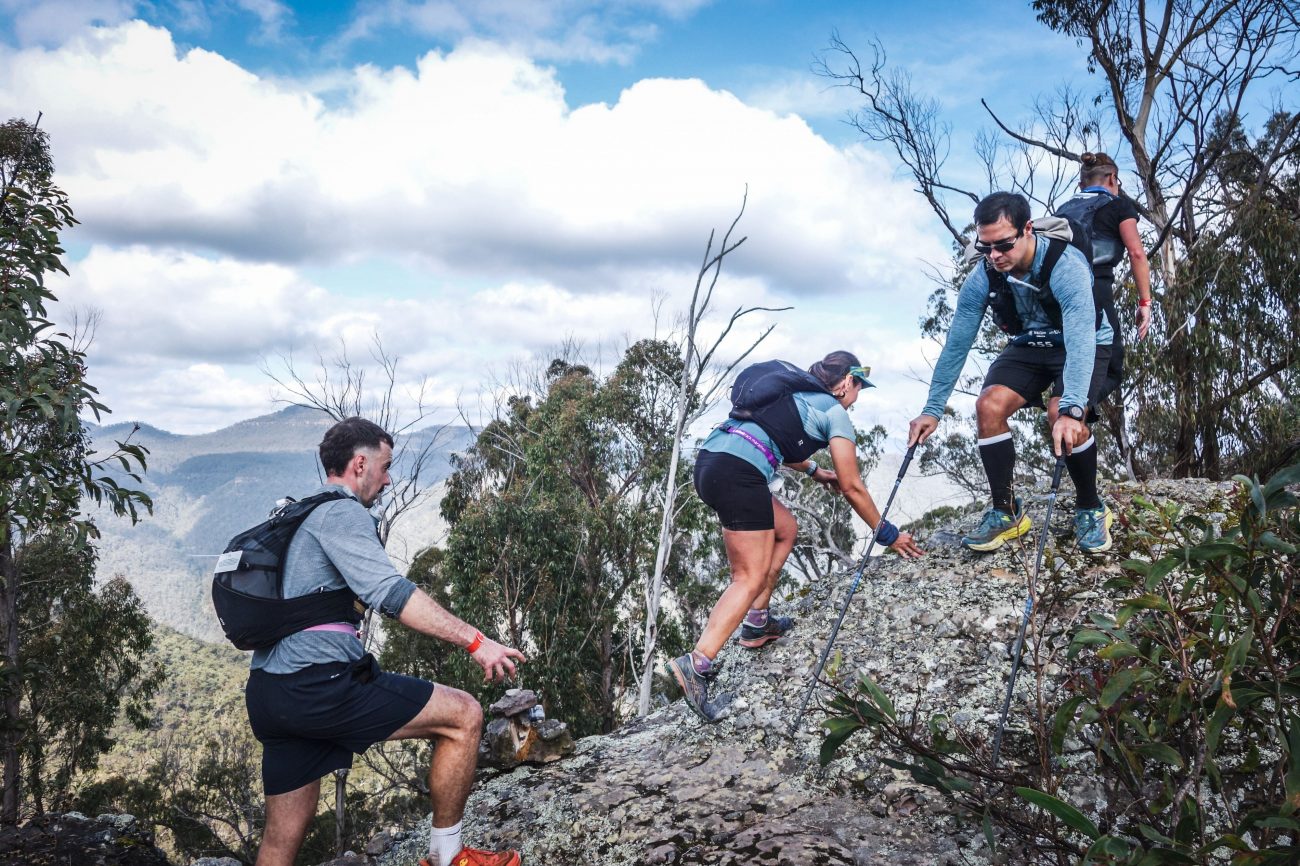
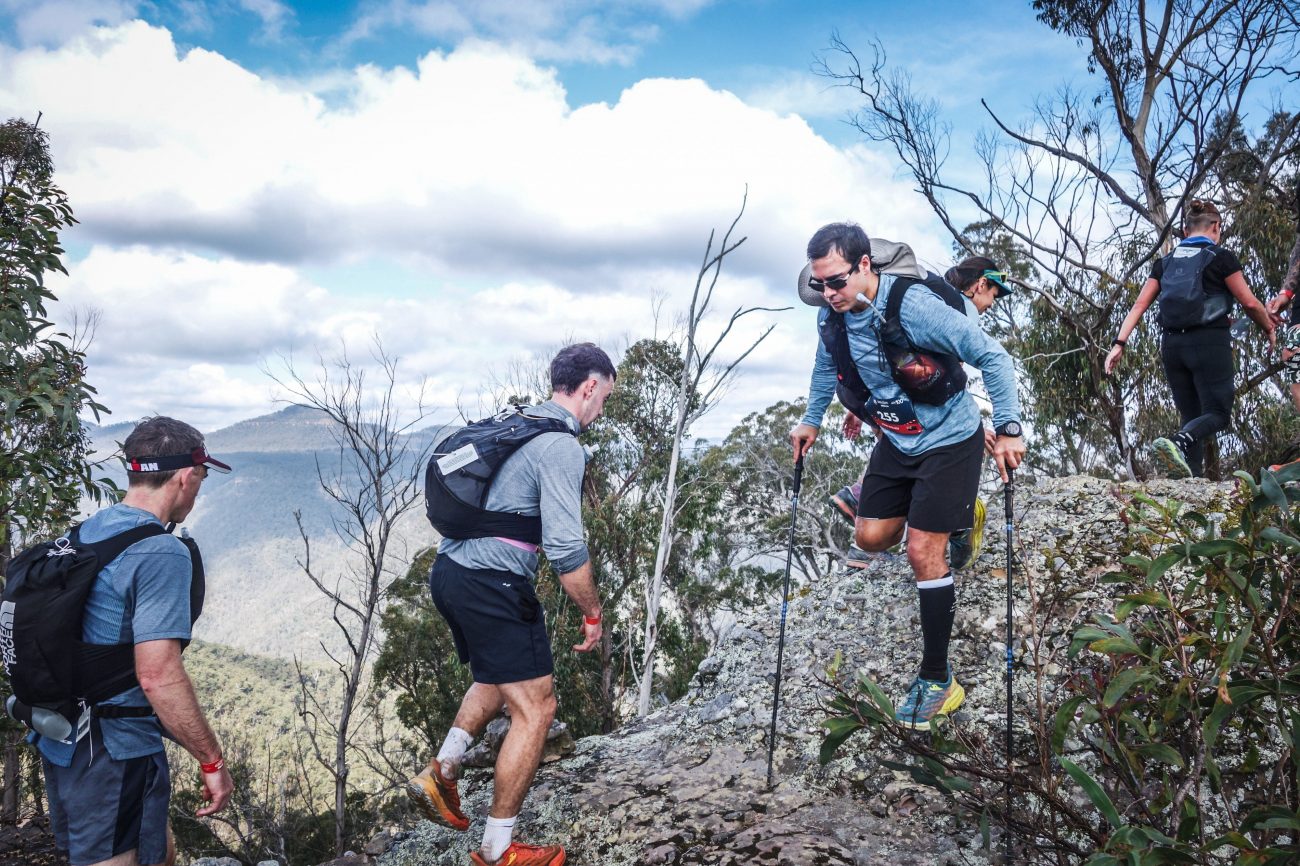
Negotiating a rock feature along Ironpot Ridge
Heading up Nellies Glen is when life as you know it becomes harder. It’s an uphill climb all the way back into Katoomba where the next aid station is. The surrounding waterways make the path muddy and you’re lost to the world shoulder to shoulder with bush. But it’s the steps up that slowly grind you down. It’s around this point that the reduction process thickens. All false pretences are ruthlessly stripped away. Any grandiose or hubris is obliterated. Your degree, status, and bank balance count for nothing during a 100km. You’re simply just another runner on the trail being reduced to nothingness like everyone else. You can’t talk your way out of this. You can’t buy your way out. You just have to survive! The steps seemed to go on forever until eventually I broke through the tree canopy again. The field was well spread so I was by myself for most of the way until I caught up to another Australian runner. We were both doing it tough so we chatted for a bit as we ran to the next aid station. The next aid station at the Katoomba Aquatic centre was a big one. It’s indoors and there’s a lot of support crew there so it’s tempting to stay put. In previous years, I’ve seen runners have a shower there and put on a fresh change of clothes. As we approach the aid station my Australian friend says “Get what you need and then get out! Get your hugs, get your kisses, and then get out!” As if realising that maybe he was assuming too much he follows “Do you have anyone waiting for you at the aid station?” “No” I respond. “My wife’s doing the 50km so unless she’s finished and decided to stick around for me, I’ll have to get my hugs and kisses from someone else.” “Good luck with that buddy” he counters. “Looks like you’re on your own. After that 50km, she’ll be back at the hotel having a hot bath.” When I finally reach the aquatic centre (57km), I’ve been going for just over 9 hours and it’s around 3.30pm. I sit down for the first time and go about sorting out my life. Knowing this would be my last day light aid station, I prepare physically and mentally for the night ahead. I topped up my Tailwind, got what I needed, and got out (minus the hugs and kisses). Thanks mate.
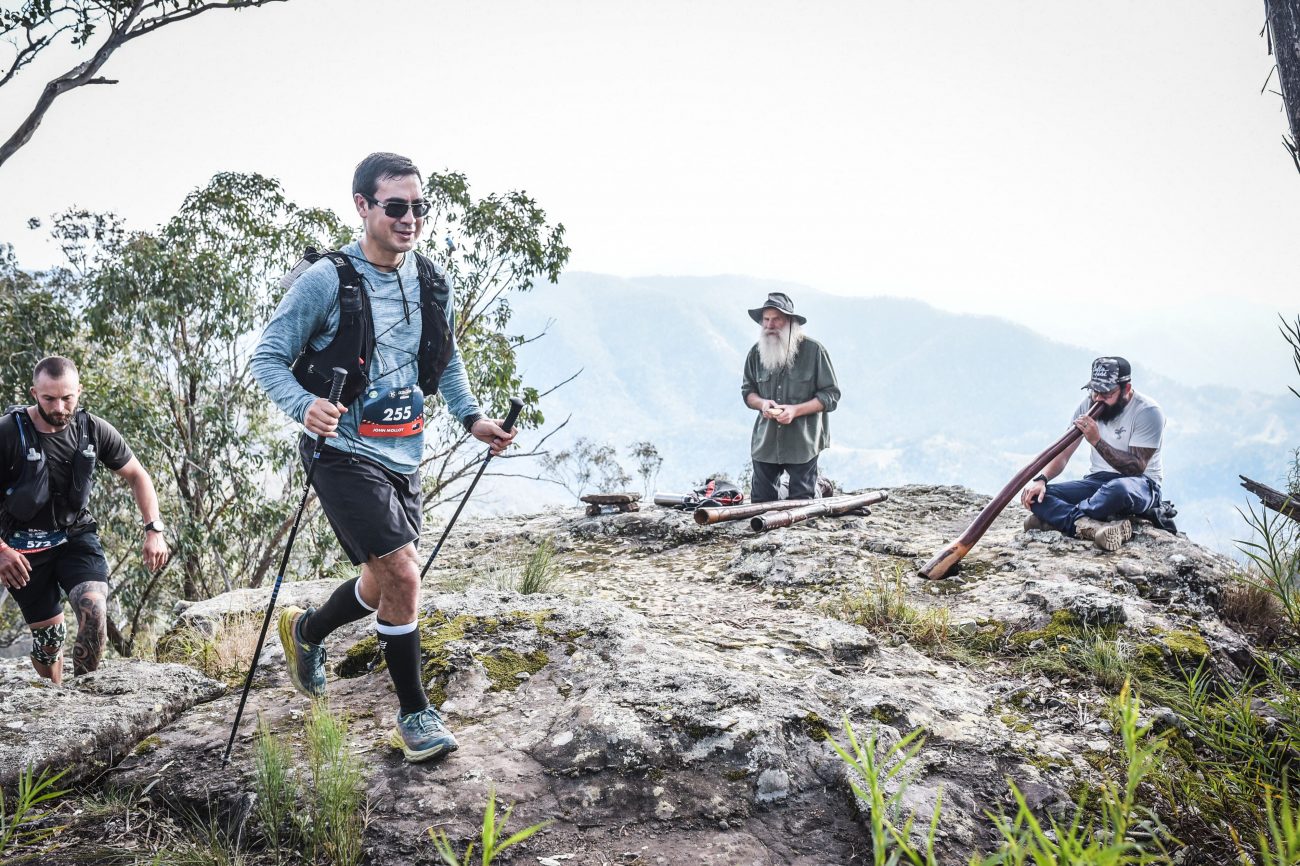
Near the turnaround point at Ironpot
The last 50km of the 100km course is essentially the majority of the 50km course. The brief afternoon rain shower had just cleared and I was back on the Prince Henry Cliff walk again but this time it was filled with tourists which kind of made me feel more human again. I couldn’t help but notice the views across the Jamison Valley (where I’d just been) and the Three Sisters (iconic rock formation of cultural significance to the Aboriginal people). Back on a concrete path, it was also a lot easier to run though the many steps continued to be challenging. In previous years, I’d usually done this section in the dark so I never really appreciated the enormity of the Giant Stairway descent until now. In case you weren’t broken and reduced already, the Giant Stairway descent (998 steps) takes you deep into the Leura Forest and deeper still into your reptilian brain which deals with instinct and survival. Though images of the Bridal Veil Falls (a multi-tiered waterfall that looks like a bridal veil) and the Leura Cascades (a smaller cascading waterfall) provided moments of lucency, the reality was, I was completely detached from the modern day world. Somewhere going up MORE steps out of the Leura Forest, I switched back into survival mode again. By the time I reached the Fairmont Resort aid station (69.5km), it was well and truly dark and I simply moved through. The darkness only narrowed my focus further. I had to get through this. I had to survive. As the night settled in, the reduction process intensified and the transformation became primal. I was no longer a man but an animal with two limbs (and sometimes four). I had become primal. I scrambled over rocks. I leapt over stepping stones. I moved swiftly in the night. I moved like my life depended on it. Though the night was dark and the trail was arduous, this was what I was made for. And something deep within me craved this feeling. I was running to survive. I was surviving by running.
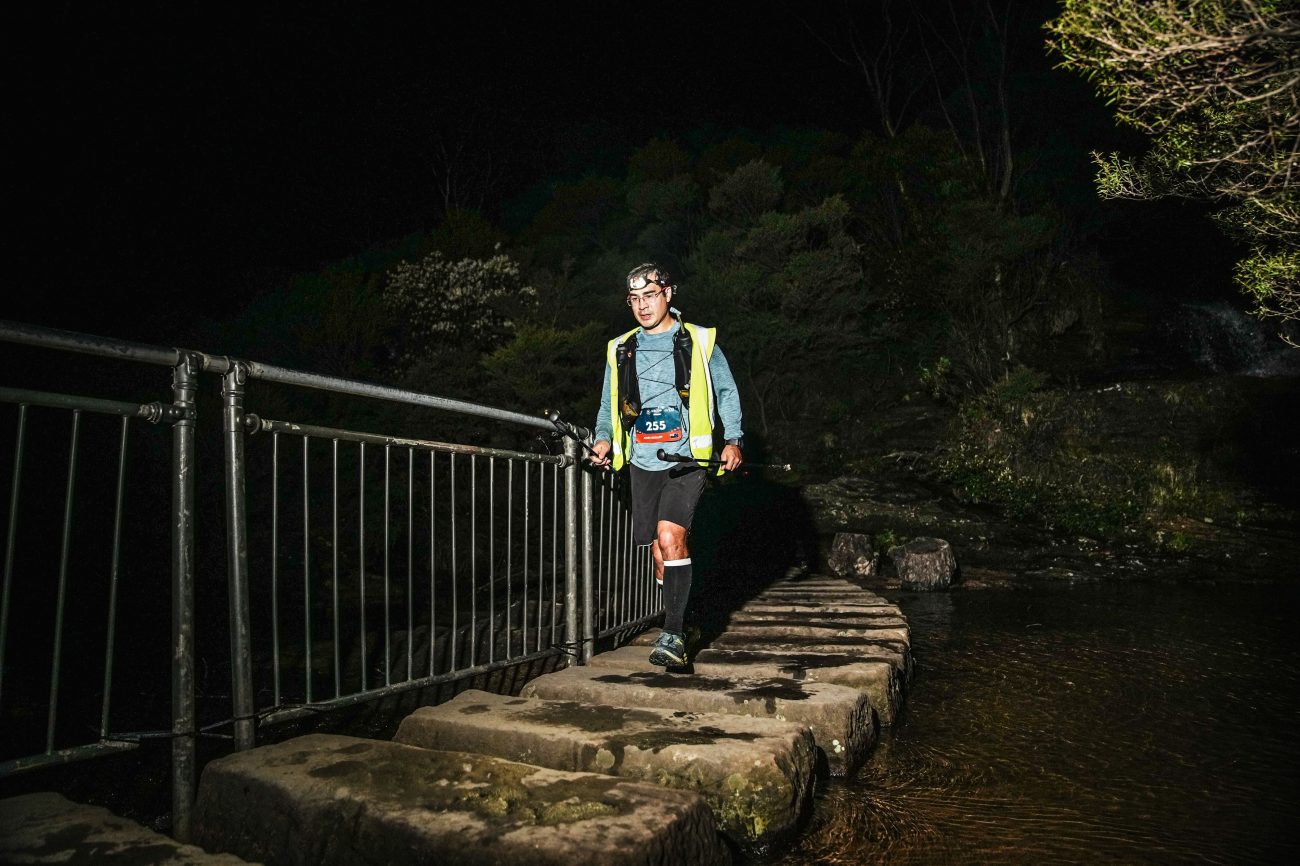
Running over stepping stones at night
By the time I arrived at the Queen Vic Hospital aid station (78km), I was pretty worse for wear. I had been running for over 13 hours and it was just before 8pm. I plonked my sorry carcass onto a seat. My ankle was playing up and my gut wasn’t happy. I could no longer handle the sweetness of my Tailwind so I changed to another electrolyte drink. A wonderful volunteer then kindly made some hot noodles for me. Another runner (whose race appeared to be over) was next to me. “That was a humbling experience” he disclosed. And so it is meant to be. This is why we do this. To keep us grounded. The final 22km of UTA is very daunting and arguably the hardest part of the whole race. After leaving Queen Vic, there’s a descent of about 800 metres over 7km followed by a 1000m ascent over 15km. Fearful of stiffening up in the cold, I left the aid station within 5 minutes. After surviving for a good 80km of this course, it was time to change my mindset. It was time to thrive. Sometimes one needs to be completely broken down in order to be rebuilt stronger. Although the sustained downhill hurt like hell to begin with, after a while, the discomfort dissipated. I began to move fluidly again. I became a predator hunting for the finishing line. Stalking and moving past shadows in the night. Moving determinedly and freely. I moved through the emergency aid station at 91km and just kept going. Eventually, I reached the 99km mark and was reunited with my old nemesis again – the Furber steps – 951 steps straight up to the finish line. Though my legs were heavy and my arms were tired, this is what they were made for. I was born a survivor. We are all born survivors. We’ve all got what it takes. But if you want to finish UTA, it will take all you have. After repeatedly being reduced, the ascension to the finish line was all part of the rebuilding process. Nine hundred and fifty one steps (and 20 minutes later), I crossed the finish line just before midnight for a total finishing time of 17 hrs and 19 mins. Thoroughly broken down in the process but ultimately stronger for it. There are many kilometres running you think you won’t survive. And then you survive. Endurance is the art of survival. Running is medicine.
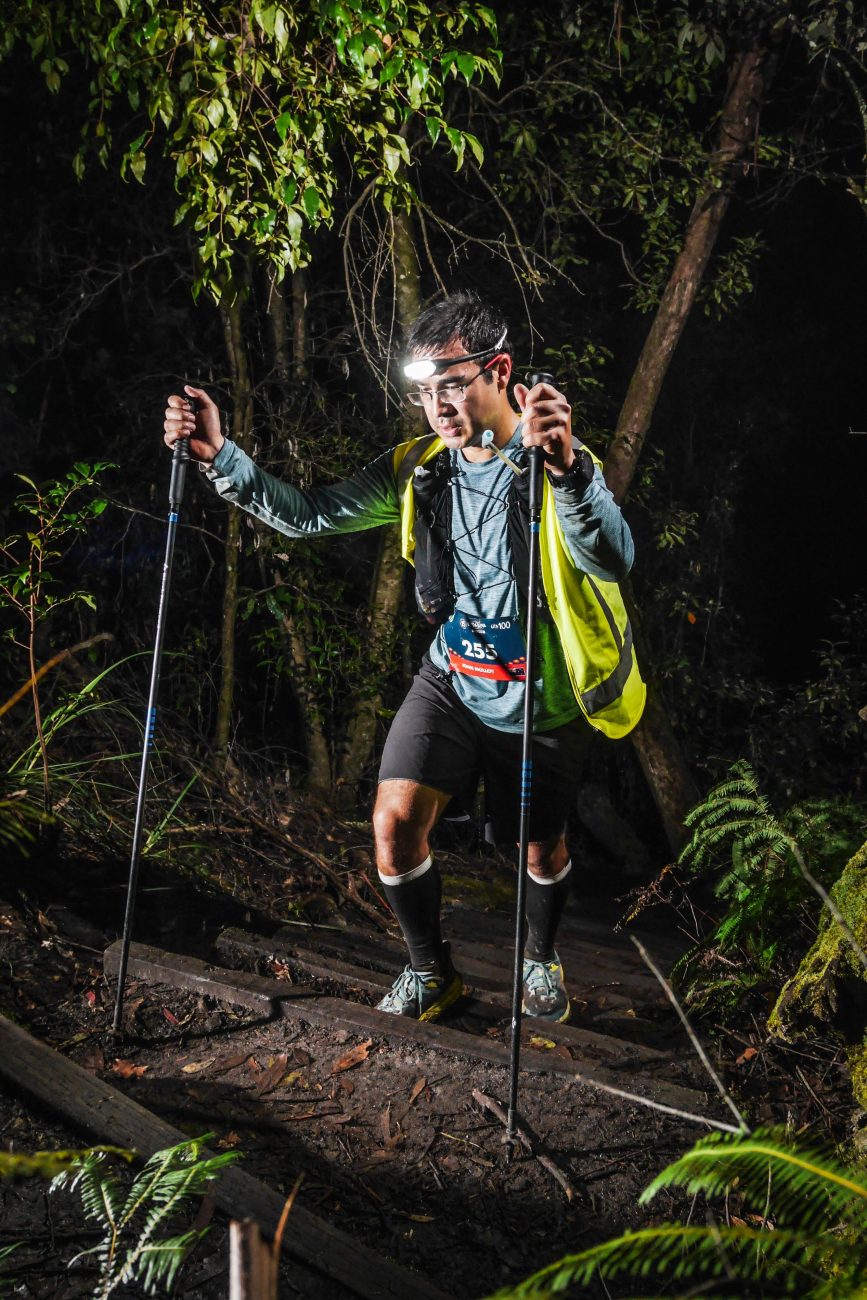
Reduced near the top of the Furber steps
Helpful tip
There are steps for Africa in the UTA 100. Make sure you train on steps.

Crossing the finish line 17 hours and 19 minutes later
